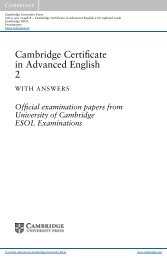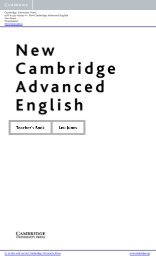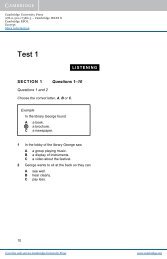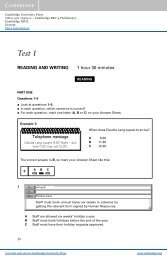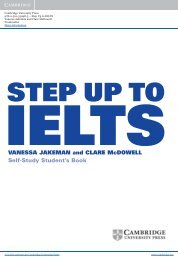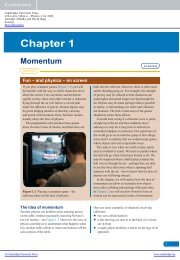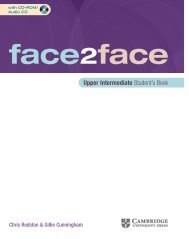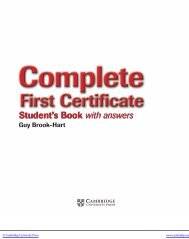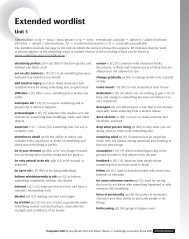2bSuggested answers• Only a little over half of the original sample replied to the postalquestionnaires.• Male respondents are under-represented in the sample.• Burke’s study makes estimates <strong>for</strong> the entire UK population based on asample size of a little over 2000 people.• The respondents are only estimating how much they think they have spent onherbal medicines, so the answers are unlikely to be very accurate.2cSuggested answers1 This is problematic. No evidence is given <strong>for</strong> this, but people are likely to feelthat it is the case through common sense.2 Burke’s study isn’t really conclusive enough to warrant the claim that it is‘clear’.3 Not very accurate. Burke’s study is based on only 2,200 responses, mainlyfrom women. Saying ‘English people’ perhaps over-generalizes the findings.Saying ‘respondents’ would make the claim seem like a more objectivestatement of the findings.4 The first is more categorical, using the word ‘shows’, while the secondacknowledges uncertainty by using ‘estimates’.5 b6 Depends to an extent on students, but, as with 2 above, it is hard to say fromthis that the claim is ‘clearly’ true.2d Student discussion3 Avoiding absolute termsNote: ‘Extreme positions’ or ‘absolute terms’ is here understood to mean categoricaltruth claims that are easily disproven, or all-encompassing statements which areunlikely to apply to everything <strong>for</strong> which the claim is made. E.g.• The Western approach to medicine is the most effective. (Categorical truthclaim)• Everybody can benefit from using traditional medicine. (All-encompassingstatement)3a Students read through several pairs of passages, in the first of which the authorhas used absolute terms, and in the second of which they have used more cautiouslanguage. Students compare the use of language in the passages, then complete thetable of ‘useful expressions’ and ‘words to avoid’.Suggested answersNote: In each passage, key terms have been underlined. In the first passage of eachpair, there<strong>for</strong>e, the underlining denotes words or phrases that should be used withcare, while in the second passage it denotes alternative phrases which are morecautious.Unit 3 Part C ∙ Investigating 88
Passage 1aIndia, like all countries, has a medical system based on the modern ‘scientific’approach to healthcare. This is the ‘Western’ system (no particular phrase toavoid, but students should be aware that it’s a strong, categorical statement,even though the accuracy of the term itself is disputed). The modern Westernmedical system relies on treating patients with high-tech equipment and expensivedrugs manufactured by multinational pharmaceutical companies. This system is onlyavailable to the rich; no ordinary Indians can af<strong>for</strong>d to use it. Furthermore, peoplenow understand that modern Western medicine is ineffective. However, because it isthe dominant system promoted by the government, people only use it because theyhave no choice.bLike many other nations, India’s medical system is based on the modern ‘scientific’approach to healthcare (sometimes known as the ‘Western’ system). The modernWestern medical system tends to rely on treating patients with high-tech equipmentand expensive drugs manufactured by multinational pharmaceutical companies.Consequently, it is limited to those who can af<strong>for</strong>d to pay. Many ordinary Indianscannot af<strong>for</strong>d to do this. A further issue with modern medicine in India is theawareness that it is not effective in every situation. However, as it is the dominantsystem promoted by the government, many Indians feel <strong>for</strong>ced to use it becausethey have no cheaper or more effective option.Passage 2aIn the past, most people visiting an acupuncturist did so because they were sufferingfrom muscular or joint pain. The proportion of people visiting acupuncturists <strong>for</strong>this reason has declined in recent years, while the proportion of people visiting anacupuncturist <strong>for</strong> other treatments (e.g. psychological, quitting smoking, or generalhealth treatments) has risen. This is due to the fact that acupuncture has becomebetter known around the world, and everybody knows that it can be used <strong>for</strong> a rangeof different treatments. In the UK, <strong>for</strong> instance, with the ban on public smoking in2007, and high tobacco prices, everyone wants to quit, and acupuncture is the mosteffective method <strong>for</strong> stopping: as a result, acupuncturists have seen large rises in thenumber of smokers visiting them.bHistorically, most visits to acupuncturists were <strong>for</strong> the treatment of muscular or jointpain. However, the proportion of people visiting acupuncturists <strong>for</strong> this reason hasdeclined in recent years, while the proportion of people visiting an acupuncturist <strong>for</strong>other treatments (e.g. psychological, quitting smoking, or general health treatments)has risen. This may be due to increasing public awareness of acupuncture; morepeople are now aware of the different range of medical problems that it can be usedto treat. In the UK, <strong>for</strong> instance, with the ban on public smoking in 2007, and hightobacco prices, increasing numbers of smokers are looking <strong>for</strong> help to quit, andacupuncture is seen as being one effective method <strong>for</strong> doing this: as a result, manyacupuncturists have seen an increase in the number of smokers visiting them.Unit 3 Part C ∙ Investigating 89
- Page 1 and 2:
Skillsfor StudyLEVEL 2Teacher’s N
- Page 3 and 4:
IntroductionThe Skills and Language
- Page 5 and 6:
Introductioncases, even in texts wh
- Page 7 and 8:
Unit 1Gender issuesUnit OverviewPar
- Page 9 and 10:
Women are oftenenrolled on lesspres
- Page 11 and 12:
2b Students take turns presenting t
- Page 13 and 14:
Note: There is a deliberate flaw in
- Page 16 and 17:
Passage cGender gap in higher educa
- Page 18 and 19:
3dAnswersThe correct readings are:F
- Page 20 and 21:
Unit Task: The gender gap1 Students
- Page 22 and 23:
1fAnswersFaiola, A. (2008, May 16).
- Page 24 and 25:
Copy information directlyfrom a lab
- Page 26 and 27:
European Commission. (2009). She Fi
- Page 28 and 29:
2cSuggested answersAccording to Fig
- Page 30 and 31:
Suggested answersGraphic Strengths
- Page 32 and 33:
Suggested answersFeatureStructures
- Page 34 and 35:
Quite separately from the issue of
- Page 36 and 37:
5b Group discussion5c Students inve
- Page 38 and 39: Unit 2WaterPart AUnderstanding spok
- Page 40 and 41: 1jAnswersYes, I agreeOn top of that
- Page 42 and 43: Assignment 1aAnswersArid: A very dr
- Page 44 and 45: Assignment 2Note: The unit task for
- Page 46 and 47: 1c Group discussion1dSuggested answ
- Page 48 and 49: 3dSuggested answers1 To determine w
- Page 50 and 51: Part CInvestigatingThe aim of this
- Page 52 and 53: 3aSuggested answersList all the pos
- Page 54 and 55: 4bSuggested answers1 introductory s
- Page 56 and 57: 4hSuggested answerProbably not real
- Page 58 and 59: Part DReporting in speechThe aim of
- Page 60 and 61: 4bSuggested answersYou want to go b
- Page 62 and 63: Part EReporting in writingThe aim o
- Page 64 and 65: 2cSuggested answersDetermining the
- Page 66 and 67: 3gExample of the rewritten sectionE
- Page 68 and 69: BDiscussionFlow rate increases with
- Page 70 and 71: Suggested answers1Feasibility repor
- Page 72 and 73: water sources is that considerable
- Page 74 and 75: we therefore recommend that the com
- Page 76 and 77: Unit 3ProgressPart AUnderstanding s
- Page 78 and 79: 4b See 4c for answers.4cAnswers3.5S
- Page 80 and 81: Unit Task: Traditional, complementa
- Page 82 and 83: 2dAnswersBeginning / ending of a se
- Page 84 and 85: 4bAnswersDate Test subjects Effects
- Page 86 and 87: Part CInvestigatingThe aim of this
- Page 90 and 91: Passage 3aStudies of acupuncture al
- Page 92 and 93: 4eSuggested answers1Presents factua
- Page 94 and 95: One study by the WHO indicates that
- Page 96 and 97: Part DReporting in speechThe aim of
- Page 98 and 99: Unit Task: Traditional, complementa
- Page 100 and 101: 1gSuggested answersSource A (Kirkup
- Page 102 and 103: Source B: Cohen, 2009.Paragraph Mai
- Page 104 and 105: So far I have successfully complete
- Page 106 and 107: Unit 4Art, creativity and designPar
- Page 108 and 109: 4.23aSuggested answers1 The survey
- Page 110 and 111: defStudents listen again to judge t
- Page 112 and 113: Note: In the next series of activit
- Page 114 and 115: 2hAnswersDefinition of contrapposto
- Page 116 and 117: 3 Reading critically3aAnswersAbilit
- Page 118 and 119: Dürer’s 1495 drawing is of class
- Page 120 and 121: To summarize, art and architecture
- Page 122 and 123: 2 Analyzing the suitability of samp
- Page 124 and 125: Part DReporting in speechThe aim of
- Page 126 and 127: 2fAnswers1 Speaker 1 gives an expli
- Page 128 and 129: 1c Note: As this activity depends t
- Page 130 and 131: Example research proposal abstract
- Page 132 and 133: 2iExample abstractFeatures of the p
- Page 134: The terms ‘Harvard style’, ‘H



